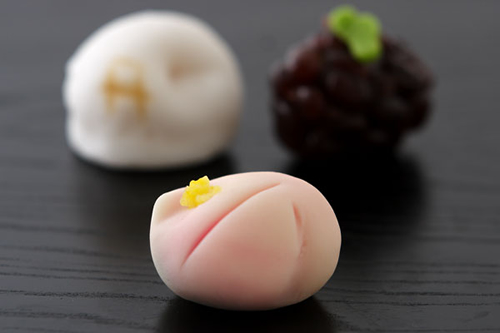Posted by TOKYO MATCHA SELECTION - Foreign staff (He is living in Japan) on 28th May 2017

I hail from a culture of home-bakers and grew up enjoying the cakes and pastries my mother made. Bought cakes were for lazy people, she would say! Indeed, shop-bought cakes always seemed either bland and tasteless, or over-sweet and sticky. So imagine my surprise when I first came to Japan and found that few people baked cakes at home, and that shop-bought cakes here are actually rather special.
But I am not alone in being admiring of Japanese confectionary; many foreign visitors go away with the same impression. From European style bakeries and patisseries, to traditional Japanese sweet makers, the real art of sweet making is something the Japanese are extremely good at.
Wagashi
Of course, looking at global eating habits, it is obvious that human beings have an incurably sweet tooth; the Japanese, perhaps, more than most. But, as with so many aspects of Japanese culture, there is an artistry and mindfulness to the preparation and serving of sweets that goes beyond simple matters of taste. Nowhere is this skill and expression more apparent than in the creation of traditional wagashi (和菓子).
Wagashi are uniquely Japanese confections often served with teas, but they are most closely associated with green teas and the tea ceremony. Anyone who understands something of Japanese eating and drinking habits will know how important the discernment of individual, discrete flavours is; for example, the sliced ginger served with sushi is intended to both cleanse the palate and prepare it for the next morsel.
So it is with wagashi, a means of sweetening the palate as counterpoint to a bitter tea.
There are many types of wagashi, some very simple, others more elaborate, though never ostentatious or vulgar. There is a modesty and contemplative quality to the artistry that goes into making and presenting wagashi, often expressed through deeply spiritual, seasonal motifs. This is common in Japanese cuisine generally; whatever is consumed has come from nature, so nature should be reflected in the presentation as well as the ingredients.
Wagashi is made with all natural ingredients derived from plants. The most common of these include: mochi - a soft, sticky kind of cake made from sweet rice flour; anko - sweetened adzuki beans and paste; shiro-an - white beans; natural sugars; kinton - sweet chestnut paste; fruits and nuts; candied burdock; macha powder; and sweet potato.
Wagashi preparation typically uses simmering and steaming techniques.
Wagashi Classification
I would hazard a guess that more wagashi is bought as gifts and souvenirs than for any other purpose. However, some fresh types of wagashi do not keep very well, so care should be taken when purchasing. There are three classifications of wagashi to help one make the right choice:
Namagashi (生菓子) - which means fresh wagashi - is made daily. Its minimum 30% moisture content greatly affects shelf life, but if it can be consumed within 48 hours, it is the very best kind to get.
Han namagashi (半生菓子), with between 10-30% moisture content, will keep a little longer.
Higashi (干菓子) includes dry confectionary containing less than 10% moisture, as well as senbe rice crackers.
I must admit, my understanding of wagashi classifications is somewhat muddy, but if I am in doubt, I ask the shop staff for their advice, or check the packaging for the use-by date. What I can do, though, is offer a few souvenir gift recommendations.
My Wagashi Recommendations
Probably the most popular and inexpensive namagashi is nama yatsuhashi - simple, flattened mochi folded over an anko (sweet adzuki bean paste) filling. Though common to Kyoto, it is sold at most airport duty free shops.
One of the oldest types of wagashi is the ubiquitous yōkan - these simple and elegant bars of gelled adzuki bean paste are a perfect compliment to teas of any kind. I prefer yōkan with the smoky black teas of China.
Another very simple and popular sweet is daifuku - a smooth mochi cake filled with anko and dusted with potato starch to prevent stickiness. Sakuramochi is quite similar, though the mochi is a delicate pink, slightly course, and wrapped in a pickled cherry leaf.
As you can tell, anko fillings are very common. In zangetsu it is folded inside a ginger-flavoured pancake, while monaka has it sandwiched inside thin, crisp rice crackers.
Manjū are steamed cakes filled with sweet red or white bean paste, chestnut or fruit paste, or puréed sweet potato. The outer soba wheat 'pastry' is sometimes flavoured with macha, and comes in shapes representing fruits or animals.
A Final Thought
Having the right kind of sweet to accompany ocha and macha, especially when entertaining guests is quite important. But not everyone who enjoys Japanese green teas can come to Japan, of course, and I presume wagashi makers in the West are a rarity. However, there are many wagashi recipes on the internet and most of the ingredients are available everywhere. So why not try and make your own?